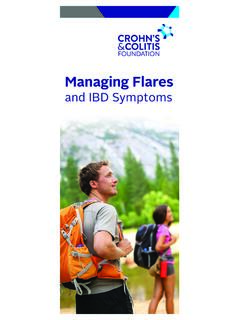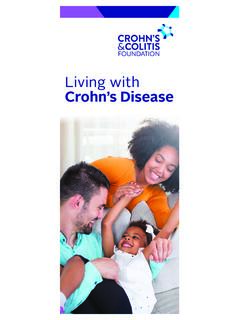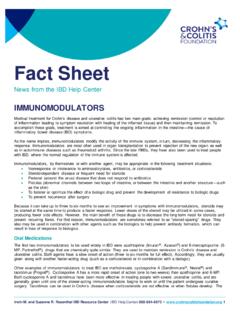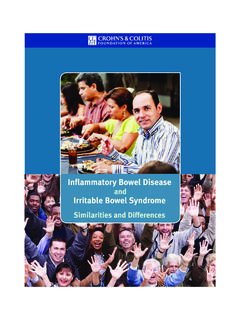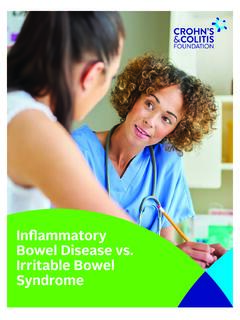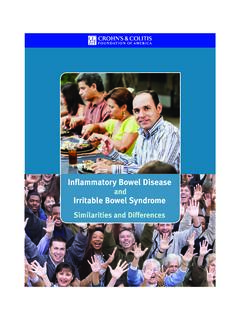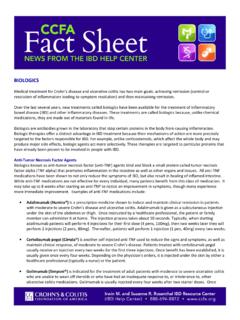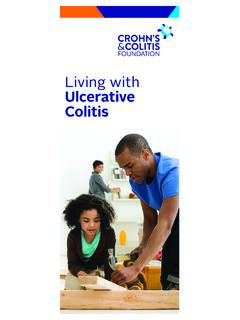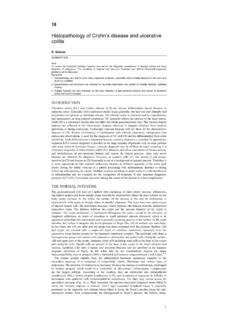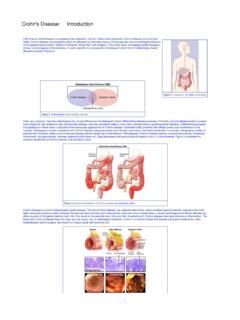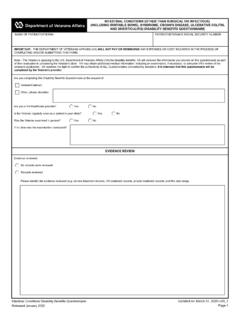Transcription of DIAGNOSING CROHN S DISEASE AND ULCERATIVE OLITIS
1 5/2010 1 DIAGNOSING CROHN S DISEASE AND ULCERATIVE colitis A variety of tests are used to diagnose and monitor CROHN s DISEASE and ULCERATIVE colitis , the two main types of inflammatory bowel DISEASE (IBD). Procedures range from simple blood tests to barium x-rays and colonoscopy, which require preparation the day before the tests. A proper diagnosis of IBD involves determining the DISEASE type ( CROHN s DISEASE or ULCERATIVE colitis ), extent and severity of DISEASE , and any related complications. Before any medical test, you may want to ask your doctor the following questions: What type of information will the test provide? What can I expect during the test?
2 Will I feel any discomfort? How do I prepare for the test? How safe is the test? How accurate? When can I expect to receive the test results? X-RAYS X-rays take a picture of the inside of the body. There are two different types of x-rays: Plain x-rays of the abdomen are a quick, easy, and inexpensive way to show narrowing of the intestines or an intestinal blockage, possibly from inflammation or scarring. Contrast x-rays track the movement of a thick, chalky liquid called barium through the intestines. If you are having contrast x-rays of the small intestine (small bowel series), you will be asked to drink barium when you arrive for the you are having contrast x-rays of the large intestine, barium will be inserted into your rectum (a barium enema).
3 (You will also need to follow a bowel cleansing routine the day before the test.) Barium should not be given if you have had a sudden, recent bowel obstruction or if you have a hole (perforation) in your intestines. Barium can cause constipation, so be sure to drink plenty of fluids after your test. COMPUTERIZED TOMOGRAPHY (CT) CT scans, also called CAT scans, take simultaneous x-rays from several different angles to create a cross-sectional image of a certain body area, like slices of a bread loaf. CT scans are mainly used to detect complications of the diseases, including abscesses, fistulas, and intestinal blockages. CT scans can also help rule out other conditions that cause symptoms similar to those associated with CROHN s DISEASE and ULCERATIVE colitis , such as appendicitis.
4 You will be asked to drink an oral contrast when you arrive for the CT scan, which may cause diarrhea. Intravenous contrast may also be injected into a vein in your arm just prior to the test; as this contrast may rarely be toxic to your kidneys, you may be asked to get a blood test to check your kidney function before the CT scan to make sure it is normal. CT Enterography MR Enterography MRI of Pelvis 5/2010 2 LEUKOCYTE SCINTIGRAPHY (WHITE BLOOD CELL SCAN) The main characteristic of CROHN s DISEASE and ULCERATIVE colitis is inflammation in the gastrointestinal tract. White blood cells are attracted to sites of inflammation. This test can see where in your body white blood cells gather, and can therefore tell how much inflammation is present.
5 Blood is taken from your arm, and white blood cells in the sample are tagged with a harmless amount of a radioactive substance. The blood is injected back into your body and a special camera is used to see where the radioactive white blood cells travel. ENDOSCOPY Endoscopy uses a thin, flexible tube called a scope to explore parts of the gastrointestinal tract. For exploration of the lower intestine or colon, the scope is inserted through the anus. To examine the esophagus, stomach and first part of your small intestine, your doctor will insert the scope through your mouth. In both instances, you ll be sedated to minimize discomfort. The scope has a lighted camera inside the tip, so your doctor can look directly at the lining of the esophagus, stomach, and intestines.
6 A new type of endoscopy called capsule enteroscopy places a mini-camera inside a tiny capsule, which you swallow like a pill. The mini-camera sends approximately 50,000 images of the portion of your small intestine that is not seen on traditional upper endoscopy or colonoscopy to a recorder that you wear on a belt, and your doctor later downloads the pictures. You pass the camera capsule painlessly through your stool. Specific types of endoscopy are named based on the part of the GI tract examined: Sigmoidoscopy examines the lining of the lower third of the large intestine (the rectum and sigmoid colon). A flexible sigmoidoscopy exam can confirm a diagnosis of ULCERATIVE colitis , CROHN s DISEASE of the lower part of the colon, the presence of inflammation, or the source of bleeding.
7 Colonoscopy examines the lining of the entire large intestine (colon) and may be used to peek into the very end of the small intestine (ileum). This exam can help determine the severity of ULCERATIVE colitis and CROHN s DISEASE as well as distinguish between the two diseases or other types of intestinal conditions. When used with biopsy (removal of a small amount of tissue), colonoscopy can detect precancerous changes and colon cancer. EGD (Esophagogastroduodenoscopy) examines the lining of the esophagus, stomach, and duodenum (first part of the small intestine). CROHN s DISEASE can affect these areas. Capsule Enteroscopy: ERCP (Endoscopic retrograde cholangiopancreatography) examines the bile ducts in the liver and the pancreatic duct.
8 A very small number of people with CROHN s DISEASE or ULCERATIVE colitis may have liver DISEASE called Primary Sclerosing Cholangitis (PSC) that can be seen with this test. Preparation for endoscopy will depend on the area being examined. If you re having an EGD or ERCP, you may be told not to eat or drink anything after midnight before the test. 5/2010 3 Colonoscopy and sigmoidoscopy (and usually capsule enteroscopy) require bowel preparation the day prior to the test to entirely cleanse the intestines. Preparation for colonoscopy is more intensive than for sigmoidoscopy. In fact, the preparation phase turns out to be more challenging than the procedure itself.
9 If you are having a colonoscopy, EGD, or ERCP, you will receive a narcotic a drug normally derived from opium or its derivatives to prevent pain, and a mild sedative to help you relax. Sometimes gastroenterologists work with anesthesiologists and/or nurse anesthesticists to administer a slightly deeper sedative (called propofol). Sigmoidoscopy is a shorter exam, and is usually done without sedation. ENDOSCOPIC ULTRASOUND (EUS) EUS is a relatively new technique in which an ultrasound probe attached to an endoscope is used to look deep below the lining of the intestines. In the setting of CROHN s DISEASE , EUS is most often used to look at fistulae in the rectal area, a complication of CROHN s DISEASE .
10 A fistula is an abnormal channel that can occur between different parts of your intestine, such as between your intestine and skin; or between your intestine and other organs such as the bladder and vagina. These channels can easily become infected, so it s critically important for your doctor to detect and treat them. SPECIAL CONSIDERATIONS If you have already been diagnosed with CROHN s DISEASE or ULCERATIVE colitis , you may need additional tests from time to time to monitor the DISEASE or diagnose possible complications, including medication side effects. It s important to follow the preparation instructions your doctor gives you for your procedure.

